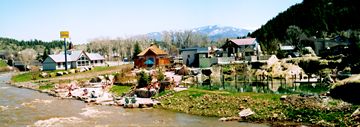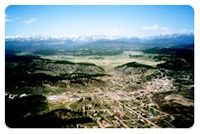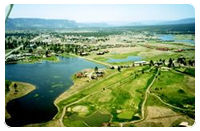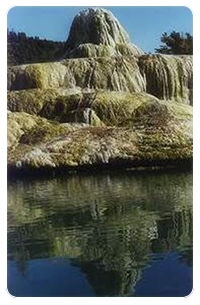
"Right in the middle of the whole damn show
was a real nice tunnel, now wouldn't you know?
Sign says clearance to the twelve-foot line,
But the chickens was stacked to thirteen-nine.
Well we shot that tunnel at a hundred-and-ten
Like gas through a funnel and eggs through a hen
And we took that top row of chickens off
Slicker than scum off a Louisiana swamp.
Went down and around and around and down
'Til we run outta ground at the edge of town.
Bashed into the side of the feed store...
In downtown Pagosa Springs."
C.W. McCall, "Wolf Creek Pass"
 In each issue, SW Aviator intends to provide our readers with fun and interesting places in and around the Southwest to fly to and to visit. We want to visit not only FBO owners, but city and county governments in order to learn and understand their interpretations of aviation in their flying communities. In each issue, SW Aviator intends to provide our readers with fun and interesting places in and around the Southwest to fly to and to visit. We want to visit not only FBO owners, but city and county governments in order to learn and understand their interpretations of aviation in their flying communities.
For this issue, we headed north from our base in Albuquerque up to Pagosa Springs, Colorado. Though marquee resort towns like Aspen, Vail and Telluride are more likely to be covered in mainstream travel publications, Pagosa Springs is as worthy a destination as any other in the state.
Flying in, one realizes that Pagosa Field—as with many Colorado airports—seems like an eagle's nest embedded among snow-covered Colorado peaks. Seated at 7700 feet and supporting an 8500 X 75 foot runway, the field is lighted and has excellent accommodations for both the corporate and private flyer.
 At the time of our visit, 100 LL was 2.13 and Jet A was 207. To hangar our plane as a transient could have been a problem on a weekend, and had we flown our Lear SS, we would have been out of luck. However, we were assured they are working on the hangar shortage. With aircraft secured, all the enchanting hideaways of south Colorado are open to exploration. At the time of our visit, 100 LL was 2.13 and Jet A was 207. To hangar our plane as a transient could have been a problem on a weekend, and had we flown our Lear SS, we would have been out of luck. However, we were assured they are working on the hangar shortage. With aircraft secured, all the enchanting hideaways of south Colorado are open to exploration.
As spring had yet to make much of a dent in the Pagosa Springs Area's white wonderland, much of our visit centered around winter sports, which can be enjoyed here longer than anywhere else in the Southwest. With Wolf Creek Pass at their back door, Pagosa claims annual average of 435 inches of snowfall, more than anywhere else in Colorado.
As a result, Wolf Creek Ski Area is a haven of fresh powder for both snowboarders and skiers alike. During our late winter visit, we spent a large portion of the daylight hours trying to balance ourselves on smooth planks—some of us for the first time—as we snowboarded from the 11,775 foot summit down to the 10,600 foot base.
 For those who prefer to tame the lesser-explored mountain areas in the vicinity, snowmobiling, snowshoeing, and cross-country skiing are also excellent options. For those who prefer to tame the lesser-explored mountain areas in the vicinity, snowmobiling, snowshoeing, and cross-country skiing are also excellent options.
Far from just a winter resort town, we were told by locals not to let the abundant snow deceive us. In the warmer times, Pagosa boasts attractions like a 27-hole championship golf course and tennis complex.
Great fishing is available almost everywhere, whether it's the lakes (Echo and Navajo), the mountain streams, or the beaver ponds. The San Juan River—which passes through the heart of Pagosa and is renowned for rafting—was also recently restored to improve its fish habitat.
Though we'd make a case for breakfast at the Irish Rose Cafe, the Chamber of Commerce proclaims the Pagosa Springs Area's most prized possession is the San Juan National Forest. It's hard to argue with them. These beautiful public lands are available for fishing, hunting, camping, hiking, birdwatching and mountain biking. When we return this summer, we are going to throw our bikes into the back of a plane and take on a few of the trails.
For less strenuous entertainment, we spent some time at the Fred Harman Art Museum—which features paintings by the creator of Red Rider and Little Beaver. Our interest in such places might date a few of us, but the museum brought back fond memories of simpler days. Pagosa Springs is also home to the Upper San Juan Historical Museum, which offers an extensive display of the area's early history.
 After a long day of fun, we shed our layers of clothes, donned our swimsuits and—despite temperatures below freezing—scurried outside and climbed into Pagosa's famous hot springs, terraced along the lovely San Juan. The Ute Indians first gave this area its name, "Pagosah," which means "healing waters." We found the name to be perfectly appropriate. After a long day of fun, we shed our layers of clothes, donned our swimsuits and—despite temperatures below freezing—scurried outside and climbed into Pagosa's famous hot springs, terraced along the lovely San Juan. The Ute Indians first gave this area its name, "Pagosah," which means "healing waters." We found the name to be perfectly appropriate.
With tired body and soul, the lure of the mineral springs was irresistible on such a crisp night. Each of the springs' pools had a different water temperature, and steam constantly rose from the waters like a London fog. As the springs restored our constitution, we briefly wondered if there was some way to fly a bathtub-sized bottle of the water back to New Mexico. We soon discarded the thought, deciding instead to fly ourselves back to enjoy the springs—and all of the Pagosa Springs Area's attractions—again as soon as possible. |

